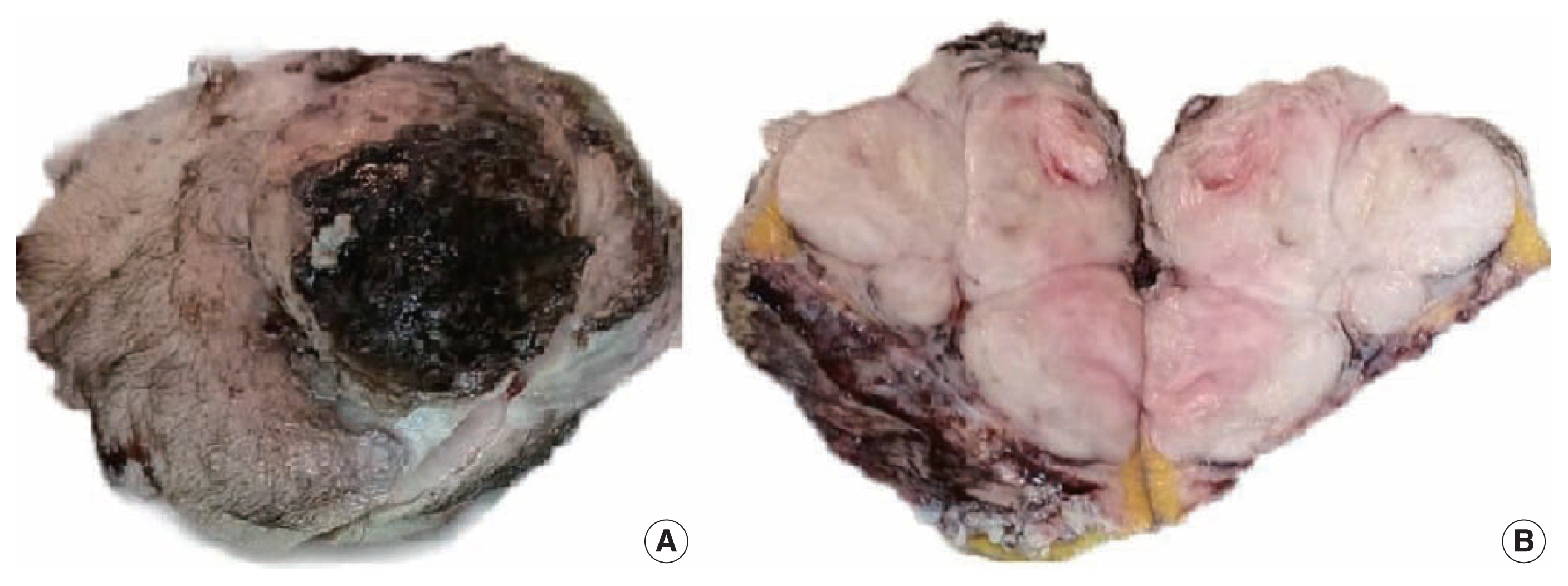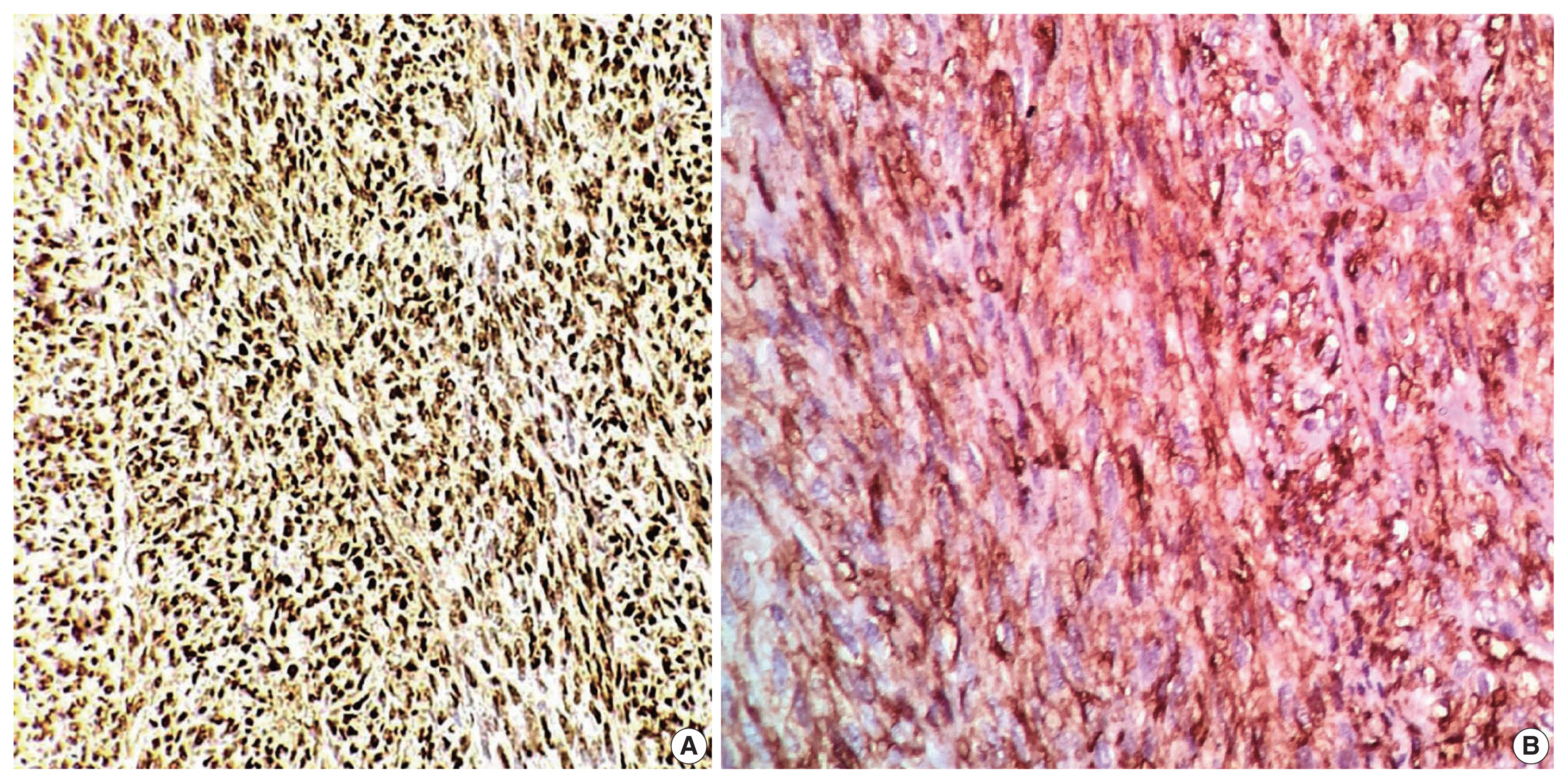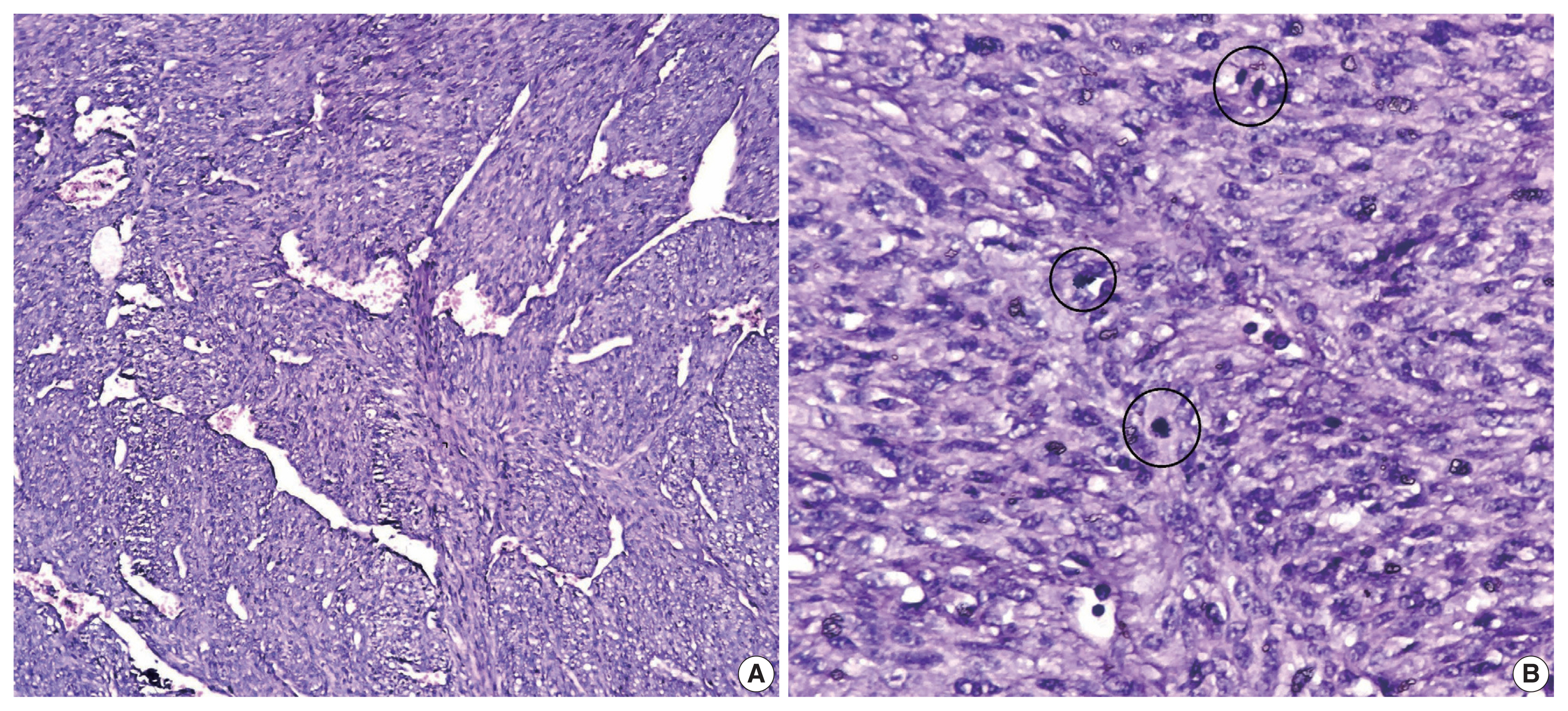Articles
- Page Path
- HOME > J Pathol Transl Med > Volume 56(2); 2022 > Article
-
Case Study
Recurrent malignant solitary fibrous tumor of the scalp: a case report and literature review -
Ahmed Rabie1
 , Abdulkarim Hasan2
, Abdulkarim Hasan2 , Yasein Mohammed2
, Yasein Mohammed2 , Ayman Abdelmaksoud3
, Ayman Abdelmaksoud3 , Ali A. Rabaan4
, Ali A. Rabaan4
-
Journal of Pathology and Translational Medicine 2022;56(2):103-108.
DOI: https://doi.org/10.4132/jptm.2021.10.29
Published online: January 21, 2022
1Department of Pathology, Faculty of Medicine, Al-Azhar University, Damietta Branch, Damietta, Egypt
2Department of Pathology, Faculty of Medicine, Al-Azhar University, Cairo, Egypt
3Mansoura Dermatology, Venereology and Leprosy Hospital, Mansoura, Egypt
4Molecular Diagnostic Laboratory, Johns Hopkins Aramco Healthcare Dhahran, Dhahran, Saudi Arabia
- Corresponding Author: Abdulkarim Hasan, MD, Department of Pathology, Faculty of Medicine, Al-Azhar University, Cairo 11884, Egypt, Tel: +20-224012932, Fax: +20-224012932, E-mail: doctorabdulkarim7@gmail.com
© 2022 The Korean Society of Pathologists/The Korean Society for Cytopathology
This is an Open Access article distributed under the terms of the Creative Commons Attribution Non-Commercial License (https://creativecommons.org/licenses/by-nc/4.0) which permits unrestricted non-commercial use, distribution, and reproduction in any medium, provided the original work is properly cited.
Figure & Data
References
Citations

- Prolonged generalized osteomalacia associated with a sinonasal cavity phosphaturic mesenchymal tumor: A case report
Mehdi Montazer, Naser Tayyebi Meibodi, Elmira Teymouri, Zohreh Mousavi, Sedigheh Reisian, Motahare Ebrahimnejad
Clinical Case Reports.2024;[Epub] CrossRef - Giant Cell Tumor of Soft Tissue on the Forearm Skin: Case Report and Literature Review
Abdulkarim Hasan, Khalid Nafie, Mohamed Adwi, Ayman Abdelmaksoud, Mohammed S. Abdelwahed, Abdulhadi Samman, Mohammad A. Alghamdi, Hasan S. Al-Ghamdi, Hind Ali Hendi, S. K. A. Horsu
Open Access Macedonian Journal of Medical Sciences.2023; 11(C): 71. CrossRef - Primary sclerosing liposarcoma of the ovary: Case report and a review of the literature
Thyagaraja Dhanurjaya, Turnbull Hilary, Jasenka Mazibrada
International Journal of Surgery Case Reports.2023; 109: 108513. CrossRef - Favorable outcome of a histiocytic sarcoma patient treated with immune checkpoint inhibitor: a case report
Long Thanh Nguyen, Giang Hoang Pham, Phuong Thi Vu, Hyeon Gyu Yi
Annals of Medicine & Surgery.2023; 85(12): 6274. CrossRef - Adrenal Solitary Fibrous Tumor: A Case Report
Elena Casademunt-Gras, Isabel Salinas, Pau Moreno Santabarbara, Gustavo Tapia Melendo, Jordi L Reverter
Cureus.2023;[Epub] CrossRef - A Rare Case of Malignant Solitary Fibrous Tumor on the Scalp
Kwang-Ryeol Kim, Ki Hong Kim
Keimyung Medical Journal.2023; 42(2): 107. CrossRef
 PubReader
PubReader ePub Link
ePub Link-
 Cite this Article
Cite this Article
- Cite this Article
-
- Close
- Download Citation
- Close
- Figure
- Related articles
-
- Clinicopathological characteristics of digestive system angioleiomyomas: case report and literature review
- Cytological characteristics of Müllerian adenosarcoma of the uterine corpus: a case report and literature review
- Composite chronic lymphocytic leukemia and mantle cell lymphoma involving the bone marrow: a case report and literature review
- Intravascular NK/T-cell lymphoma: a case report and literature review
- Metastatic choroidal melanoma in the breast: a case report and review of the literature



Fig. 1
Fig. 2
Fig. 3
| Reference | Site | Age (yr) | Sex | Tumor behavior | Tumor size (cm) | + ve stains | − ve stains |
|---|---|---|---|---|---|---|---|
| Present case | Scalp (occipital) | 51 | M | Malignant | 8 × 7 | CD34, STAT6, Ki67 (30%) | SOX10, actin, desmin, S100, pan-CK, EMA |
| Vasile et al. (2020) [ |
Scalp (meningeal-derived) | 68 | M | Malignant | 6 × 4 | STAT6, BCL2, CD99, vimentin | CK, CK5/2, keratin 34 beta E-12, EMA, P40, S-100, MART-1, desmin, progesterone receptor |
| Mori et al. (2018) [ |
Scalp (mid-occipital) | 37 | F | Benign | 2.5 × 2 | CD34, STAT6 | S-100, Melan-A, Sox10 |
| Feasel et al. (2018) [ |
Scalp | 81 | F | Benign | 4 | CD34, STAT6 | S-100, cytokeratins |
| 55 | F | 1.8 | |||||
| 64 | F | 2 | |||||
| 31 | F | 3 | |||||
| 31 | F | NA | |||||
| Kim et al. (2017) [ |
Scalp (left side) | 20 | F | Benign (myxoid) | 4 × 1.5 | CD34 | BCL2, SMA, S-100, desmin |
| Shirley et al. (2016) [ |
Scalp (posterior) | 37 | F | Malignant | 6 × 4.5 | FLI-1, BCL2, CD99, CD34 | CD57, EMA, HMB-45, S100, CD31 |
| Omori et al. (2014) [ |
Scalp (posterior) | 64 | M | Benign | 4.5 × 2 | CD34, BCL2 | EMA, SMA, desmin, S-100 |
| Rizk et al. (2013) [ |
Scalp (parietal region) | 2 | M | Benign | NA | CD34 | SMA, desmin, h-caldesmon, S-100 |
| Tourabi et al. (2008) [ |
Scalp (left occipital) | - | - | Benign | NA | NA | NA |
| Erdag et al. (2007) [ |
Scalp | 58 | M | Benign | NA | CD34, CD99 | Keratin, EMA, desmin, S-100 |
| Ramdial and Madaree (2001) [ |
Scalp | 2.5 | F | Benign (aggressiv) | 15.5 | CD34 | Desmin, S-100 |
| Cowper et al. (1999) [ |
Scalp | 38 | M | Benign | 4 | CD34, vimentin | Cytokeratin, EMA, SMA, desmin, factor XIIIa, S-100 |
| Okamura et al. (1997) [ |
Scalp (subcutabous) | 37 | F | Benign | NA | CD34 | Markers for smooth muscle, neural, and epithelial differentiation |
SFT, solitary fibrous tumor; STAT6, signal transducer, and activator of transcription 6; CK, cytokeratin; EMA, epithelial membrane antigen; BCL-2, B-cell lymphoma 2; NA, not available; SMA, smooth muscle actin.

 E-submission
E-submission








